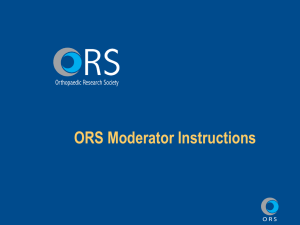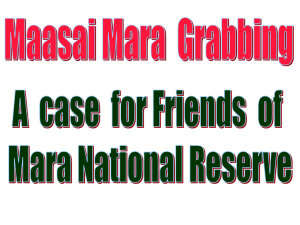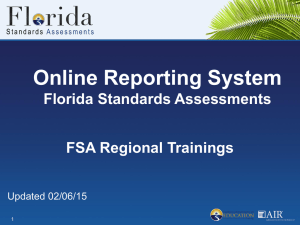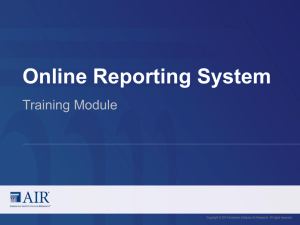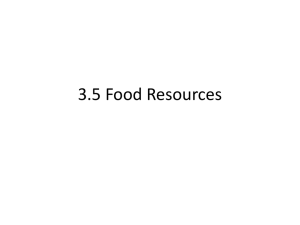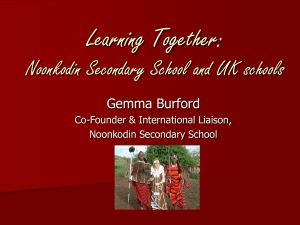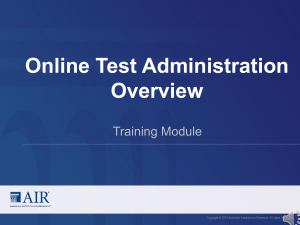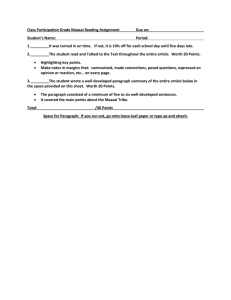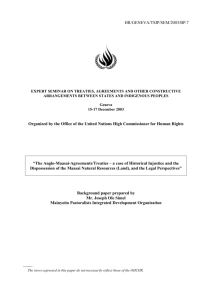the role of community media in tanzania: challenges
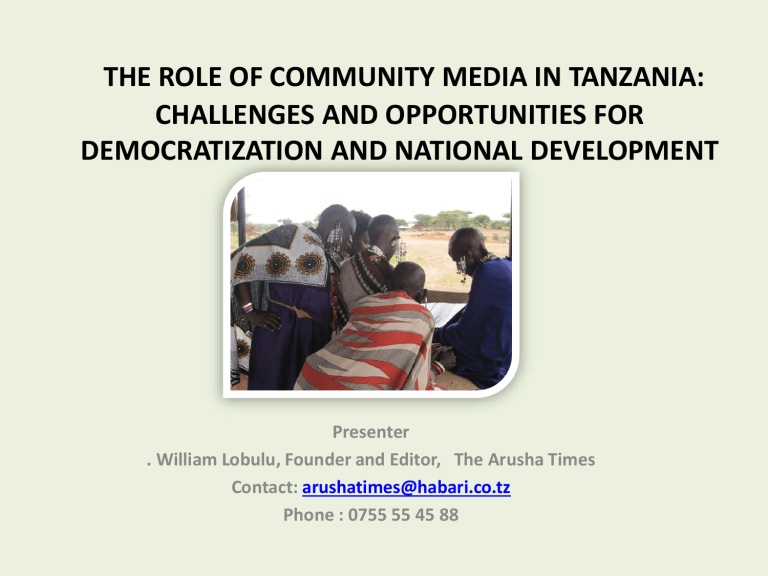
THE ROLE OF COMMUNITY MEDIA IN TANZANIA:
CHALLENGES AND OPPORTUNITIES FOR
DEMOCRATIZATION AND NATIONAL DEVELOPMENT
Presenter
. William Lobulu, Founder and Editor, The Arusha Times
Contact: arushatimes@habari.co.tz
Phone : 0755 55 45 88
CONTENT OF PRESENTATION
• Introduction
• Problem Statement
• Purpose of Study
• Definitions of Terms
• Limitations and Delimitations of the Study
• Review of Related Literature
• Research Methodology
• Research Results and Discussions
• Summary, Conclusion and Recommendations
INTRODUCTION
Quotation
“I would rather live in a country with newspapers (Press) and without a government than in a country with a government but without newspapers (Press).”
Thomas Jefferson, third President of the United States,
March 1801 to March 1809 dictum.
INTRODUCTION
• Without mass media the society would be lacking an important pillar.
• Mass media inform, interpret, educate, persuade and entertain.
• Generally they spearhead (lead) social-economic change in society.
• Such change has not been realized because media is either state owned or profit motivated.
• Private media making frequent calls for good governance, accountability, freedom of speech, etc but limited to urban areas.
PROBLEM STATEMENT
• Limited reach of so-called national media despite large numbers. (Radio 45), TV (27), Dailies (14), Weeklies (30).
• About 80 per cent of people who live in Tanzania are not adequately served by the media.
• Irrelevant content and often determined by ownership.
Not suited to democratize or stimulate communities for development.
• National media do not give rural people access to participation.
• Government does not support widespread establishment of Community Media i.e. lack of an enabling environment.
• Lack of awareness of role of Community Media in democratization and national development.
PURPOSE OF STUDY
• To examine the role of
Community Media in democratization and national development.
What are the challenges and opportunities?
• To find out whether
Community Media can help achieve basic elements of democracy by creating an informed public.
Assumption
• If more community media were established and sustained in rural areas of
Tanzania the majority of people would have influence in decision making and national development especially in view of current technological advancements in broadcasting, telecommunication and the internet.
What is envisaged
• To generate information that might influence media stakeholders focus in supporting Community
Media outlet. Findings of this study will help them realize which medium is better placed in giving a voice to masses especially those in rural areas.
RESEARCH QUESTIONS
• To what extent do members of the pastoral community use community radio as a source of information?
• Apart from community radio what other sources of information are accessible to members of the community?
• How do age, gender and level of education influence community radio use?
• Does the source of income of listeners influence community radio use?
• What are the listeners’ information needs and interest in the area of studies?
• To what extent have the community radio broad cast stimulated people’s participation in affairs concerning their development.
• To what extent have community radio broadcast influenced changes within the pastoralists communities?
• What are the socio-economic problems which people think could be solved through Community Media mobilization of its audience?
• What are the challenges and opportunities that influence the use of
Community Media structures in enhancing democracy and national development?
DEFINITION OF TERMS
COMMUNITY MEDIA
• No single definition of Community Media.
• Reviewed Bruce Girard, Chester Heder, Kelvin Howely,
Kennedy Javaru definitions.
• Javaru for example defines Community Media as those that are devoted to the social, political and cultural interests and aspiration of identifiable groups resident particular geographical areas within a country/or with specific experiences and interests.
• For this study Community Media is defined as forms of communication created specifically 56o serve a geographical area inhabited by people with generally common interest who own and control the media structure. Such structure could however have financial support of donors.
DEFINITION OF TERMS
DEVELOPMENT
• There are myriad definitions of the term development.
• Wilbur Schramm dwells on set of human transformation which require people to be educated, informed, attitudes and values be changed, human relations, customs and social behavior be reviewed and rethought .
• For this study development is defined as transformation from grinding poverty to improved standards of living through institutional and attitude changes and improved income.
DEMOCRATIZATION
• Long process and it comes gradually.
• Various definitions.
• For the purpose of this study democratization is a transition from authoritarian practices in governance to enabling people exercise freedom in participation and deciding matters that concern their own development and wellbeing either collectively or individually, the process of empowering people being undertaken mainly through the mass media.
LITERATURE REVIEW
• Studies since 1920s indicate that appeal more to urban people more than rural areas
(relevance).
• Common people have limited access to mainstream mass media.
• Most mainstream media are geared toward profit making.
• In the 1970s the usefulness and relevance of
Community Media was realized.
LITERATURE REVIEW
Media growth in four phases:
• Colonial phase/support to administration.
• Pre-independence phase-support to local papers.
• Post independence phase – party/government papers
• Liberalization phase (multi-partism)
• Growth of private press.
LITERATURE REVIEW
Community Media in Tanzania
• Efforts started with UNESCO in 1970s.
• Community Media partnership organization a number of Community Media in Tanzania, most of them FM radio station – FADECO in
Karagweni Michweni Pemba, Orkorenei FM, etc.
• Studies by – Mrutu – Community Radio in
Africa, Jallow, Oleniini
METHODOLOGY
• CASE STUDY: Orkonerei FM Radio service 94.4 ORS in
Simanjiro District since 2002.
• Owned and controlled by community. Orkonerei FM was establish to enhance Maasai pastoralists in Arusha,
Manyara, Kilimanjaro regions.
• STUDY POPULATION: Simanjiro (Manyara region), Longido
(Arusha region), Same (Kilimanjaro region).
• POPULATION SAMPLE: Adult residents, random selection.
• Pastoralists community.
• Systematic sampling not possible.
• Males 103 = 59%.
• Females 73 = 42%.
METHODOLOGY
• QUANTITATIVE - total 180 respondents – 60 in each district, 14 different villages.
• Confidence level 95%
• Closed and Open questionnaires.
• 18 Maasai interviewers engaged.
QUALITATIVE:
• Referral sampling
• Added vivid explanations and human side of what is being investigated.
• In-depth interview: ORS officials, IOPA officials, Government institutions, Tanzania
Media Fund, Documentary
FOCUS GROUP DISCUSSION
• Held in Maasai then transcribed.
• 3-8 groups with moderator.
• Picked randomly.
• Focused on media seeking behaviour.
• How media communication has impacted social development i.e. health, education, environment, livestock and energy.
• Responses not quatified as purposes not consensus but respondents’ opinions and perspectives.
Study Findings from Quantitative
Survey Analysis
Community radio as source of information
Total
83,1 16,9
Same
60,3 39,7
Longido
90 10
Simanjiro
98,3 1,7
0 10 20 30 40 50
%
60 70 80 90 100
Yes
No
Community radio as source of info
• Radio of Choice for the 3 pastoralist districts
• Of 180 individuals 83.1 per cent listened to
ORS.
• Source of information despite age, sex, education and occupation.
• Closer the community to broadcast transmission the higher the number of people who listened.
Radio is main source of info
60
59
54
50
40
40
46
30
26
32
28
27
28
37
39
31
20
10
0
16
2
Radio Television Word of mouth
8
2
5
0
Papers Telephone Internet
Simanjiro
Longido
Same
Other sources of information
1. Radio is the main source of information. Others are:
2. Word of Mouth
3. Telephone
4. Newspapers
5. Television
6. Internet.
• Person to person communication is more important in Same where ORS signal is weak.
• Cell phones have major role to play in rural communication.
• Attracts people of all walks of life.
• Among those who said they did not listen to ORS
67.9% had no formal education.
Age, sex, education & use of radio
• Among those who said they did not listen to ORS 67.9% had no formal education.
• Table 4
• Men in all three districts are predominant in listenership.
• People in the 31 to 40 age group are more keen to listen to
ORS (37.19)
• Graph 6
• In the age category between 21 and 30 years that more women (35%) than men 10% listened to ORS).
• Graph 7
50
40
%
30
20
10
0
Age, gender listeners
Male
Female
60
50
40
30
20
10
0
Listeners’ source of income
Simanjiro
Longido
Same
Listener's info needs
60
50
40
30
20
10
0
52
15
39
36
Ufugaji bora
Elimu Habari Kipindi cha dini
No per programme
Listeners’ preferences
• Most listeners prefer informative programmes on livestock
• Graph 9
• Ufugaji bora rated as most preferred programme
(also in Maasai)
• News in Maasai language is most captivating
• Strong liking for educative news
• 31-40 years age-group showed much interest in educative information
• Most respondents preferred listening to radio at night (43.9%)
Influence in public participation
• Individuals invited to studio to discuss topical issues
• Listeners call in to discuss issue being aired
• Presenters call particular individuals
• Reporters go around villages to collect and engage villagers in discussion
• Traditional dance groups invited to studio.
• 31-40 years age group is most active in participation: Table 5
• More males than females participate 70.3% and
29.7% respectively.
• About 82% of respondents had attended village meetings.
Radio use in Changes
• Responses indicate that community radio can change attitudes, mobilize people and facilitate development.
• Maasai now keep livestock for other purposes rather than prestige.
• They also seek more information to meet their needs to improve economic activities.
• Community radio seen to have brought positive changes in livestock keeping and farming.
• Community radio spearheading nomadic pastoralists shift to agro-pastoralism.
DISCUSSION
• Ownership is crucial in determining mass media role.
• Modernization theorists view the state as the main actor in modernizing underdeveloped societies.
Practice shows state owned media are not ideal for social change and development.
• “Independent” media owned by private entrepreneurs aim at making profit.
Often they serve interest of the ruling class.
They tend to support the status quo as they also operate other businesses that need government favour.
• Community media has the ability to empower communities and create social change.
Radio is most preferred and useful community medium.
ORS instrumental in effecting change e.g. from pastoralism to agropastoralism.
NGOs and others use radio for advocacy.
Further discussion
Participation
• Community Media helps create an informed audience and confidence to participate in public affairs.
Social change
• A study shows Community Media ability to alter social behaviour and structures:
• Behaviour change toward Female Genital Mutilation – abandoned or done secretly.
• Marrying off girls at early age addressed.
• Esoto rite of passage almost abandoned.
Development Agenda:
• ORS has adequately addressed health, nutrition environment, farming, animal husbandry entrepreneurship, etc and had an impact on people’s livelihood.
• The radio station has led to successful implementation of various development projects in the catchment area e.g. improved breeds, destocking.
• ORS listeners are early adopters of innovations and followed by others in phases.
CHALLENGES
Limitation in development aspects
Radio is widely used and has many advantages but physical demonstration which is the best way to impart knowledge and skills to a large illiterate population cannot be performed. Radio/TV combination is best.
Setting Agenda
Most community media heavily dependent on donors and may set their own agendas.
Substantiality
When donors pull out project is left without operational funds.
Legislations & Regulations
TCRA regulations limit community radio stations a 100km reach and transmission power of no more than 100 watts. Maasai are across
Tanzania.
Language
Restricted to either Kiswahili or English. Only allowed 10% Maasai language airtime .
OPPORTUNITIES
ACCEPTANCE
• Community identify themselves with community “own” media.
Loyal audience cuts across all age groups, gender and occupation.
• Engages even the most marginalize.
• Cell phones have enhanced participation.
FUNDING SUPPORT
•
Impact studies have led to availability of funds across the worldfoundations, World Bank, UNESCO, USAID, and UNFAO.
• World Association of Community Broadcasters ensures also sustainability.
• Media Fund also aims at giving rural people a voice.
• Issues that attract funding from the Media Fund are community media concerns such as health, agriculture, environment, good governance, gender equality, education, etc.
OPPORTUNITIES
DIMINISHING STATE GRIP
• Democratization going in tandem with liberalization of media communication.
• TCRA lists community broadcasting as one of the categories of licensees.
• TCRA claims it takes two months for a radio or TV to be licensed. It took almost 10 years for ORS.
• According to officials of Newspaper Registry claim it takes s seven (7) days to have a newspaper registered.
LOW COST OPERATIONS
• FM broadcasting equipment have become substantially low in prices (US$
20,000).
• Donor often willing to pay for initial capital costs.
• NGOs willing to sponsor educational programmes.
• Local Government also cut down logistic costs if they used community based media.
• Easier and cheaper to create content for Community Media.
SUMMARY/CONCLUSION
• Study revealed potentials of community radio to meet information needs of community
Relevant content, gives access to people it serves.
Provides forum for discussion and decision making.
• Study revealed that community radio has contributed to social
change among Maasai pastoralists.
Education, health, FGM, shift to agro-pastoralism,
• Development and operations of community media faces funding and sustainability challenges but outweighed by opportunities.
Challenges- demo limitations, following donors’ agenda, sustainability, legislations and regulations, language
Opportunities: acceptance, funding support, diminishing state grip, low cost operations
Study shows that ORS has been able to address development issues on health, education, nutrition, gender equality, land use, etc.
Community Media (radios) plays its role as catalyst for development.
• There is need for further research on Community Media sustainability and vulnerability (pushing agenda of funders)
